Malaria Prevention and Management Strategies for Travelers Report
VerifiedAdded on 2019/09/16
|11
|3280
|250
Report
AI Summary
This report provides a comprehensive overview of malaria prevention and management strategies for travellers. It begins with an introduction to the increasing risk of malaria for international travellers, highlighting the significance of understanding and implementing prevention methods. The report outlines the "ABCD" approach to malaria prevention, including understanding the traveller's itinerary, assessing awareness and risks, avoiding mosquito bites, and considering chemoprophylaxis. Detailed methods for mosquito bite avoidance are discussed, including the use of repellents, protective clothing, and insecticide-treated bed nets. The report also addresses areas where Plasmodium falciparum is resistant to chloroquine and emphasizes the importance of proper diagnosis and timely treatment. The report highlights key questions to assess an individual's risk and discusses chemoprophylaxis, including the use of antimalarial drugs and vaccines. The importance of environmental hygiene and health education in preventing malaria is also emphasized, providing a complete guide to managing and preventing malaria in travellers.
Contribute Materials
Your contribution can guide someone’s learning journey. Share your
documents today.
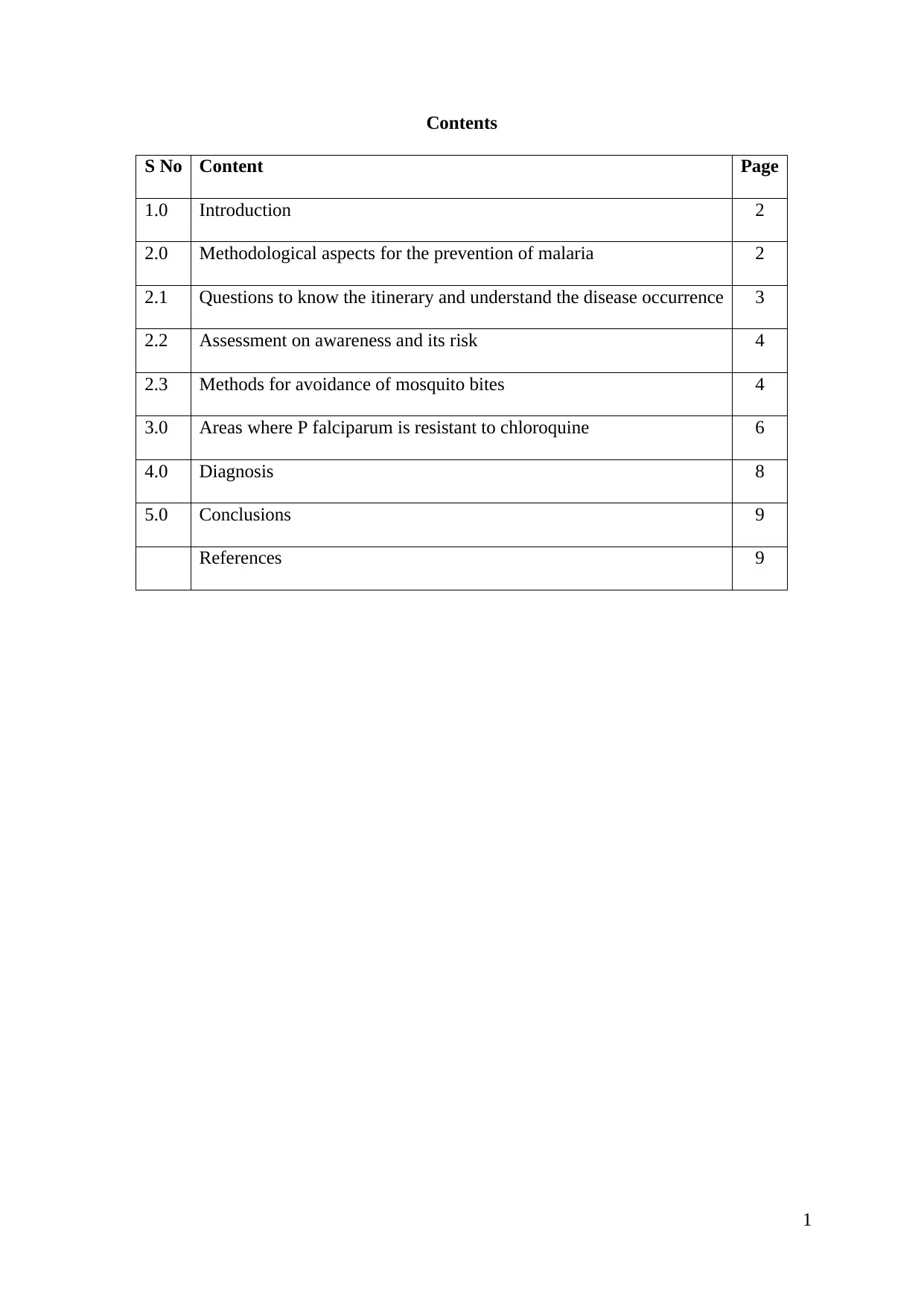
Contents
S No Content Page
1.0 Introduction 2
2.0 Methodological aspects for the prevention of malaria 2
2.1 Questions to know the itinerary and understand the disease occurrence 3
2.2 Assessment on awareness and its risk 4
2.3 Methods for avoidance of mosquito bites 4
3.0 Areas where P falciparum is resistant to chloroquine 6
4.0 Diagnosis 8
5.0 Conclusions 9
References 9
1
S No Content Page
1.0 Introduction 2
2.0 Methodological aspects for the prevention of malaria 2
2.1 Questions to know the itinerary and understand the disease occurrence 3
2.2 Assessment on awareness and its risk 4
2.3 Methods for avoidance of mosquito bites 4
3.0 Areas where P falciparum is resistant to chloroquine 6
4.0 Diagnosis 8
5.0 Conclusions 9
References 9
1
Secure Best Marks with AI Grader
Need help grading? Try our AI Grader for instant feedback on your assignments.
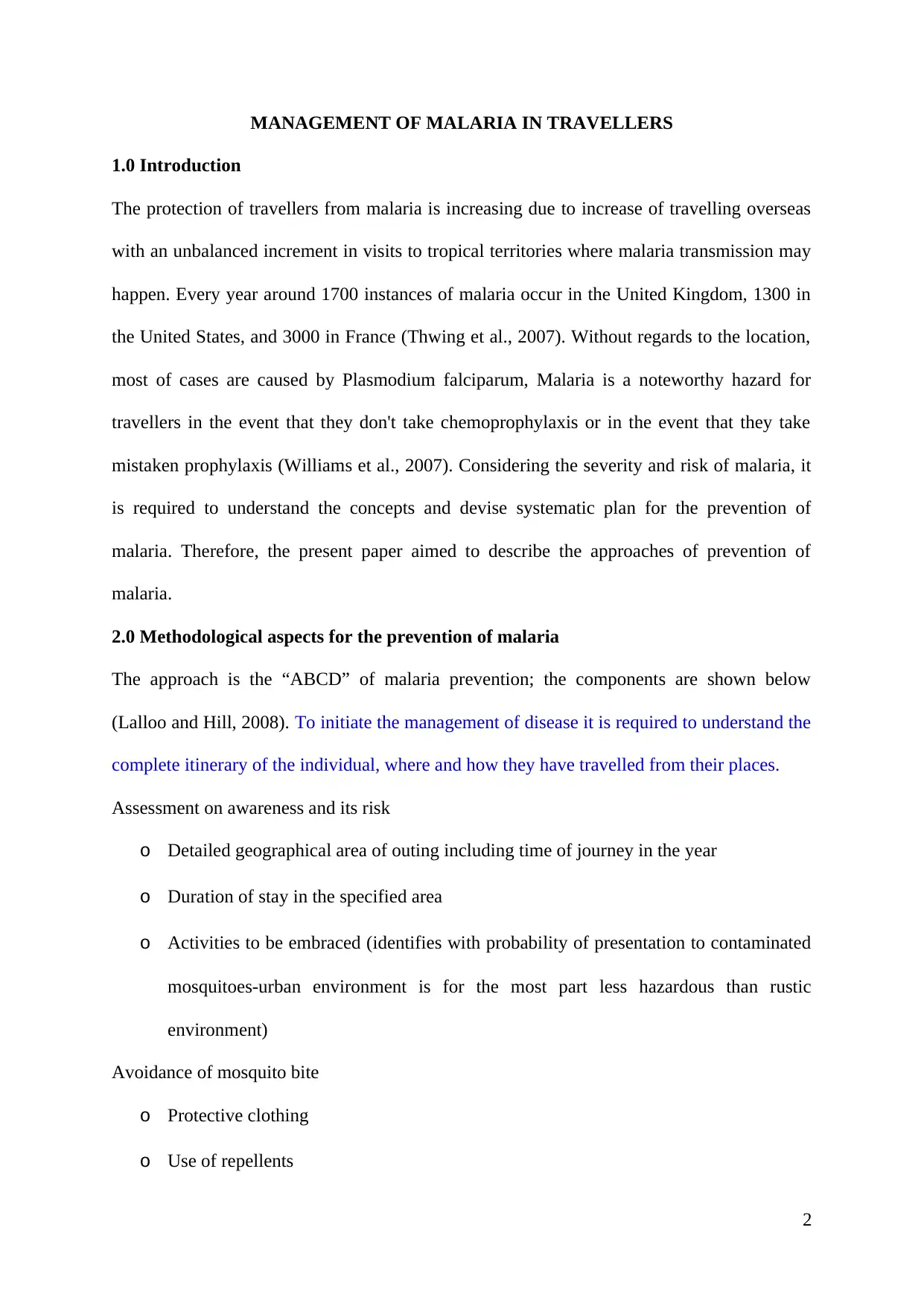
MANAGEMENT OF MALARIA IN TRAVELLERS
1.0 Introduction
The protection of travellers from malaria is increasing due to increase of travelling overseas
with an unbalanced increment in visits to tropical territories where malaria transmission may
happen. Every year around 1700 instances of malaria occur in the United Kingdom, 1300 in
the United States, and 3000 in France (Thwing et al., 2007). Without regards to the location,
most of cases are caused by Plasmodium falciparum, Malaria is a noteworthy hazard for
travellers in the event that they don't take chemoprophylaxis or in the event that they take
mistaken prophylaxis (Williams et al., 2007). Considering the severity and risk of malaria, it
is required to understand the concepts and devise systematic plan for the prevention of
malaria. Therefore, the present paper aimed to describe the approaches of prevention of
malaria.
2.0 Methodological aspects for the prevention of malaria
The approach is the “ABCD” of malaria prevention; the components are shown below
(Lalloo and Hill, 2008). To initiate the management of disease it is required to understand the
complete itinerary of the individual, where and how they have travelled from their places.
Assessment on awareness and its risk
o Detailed geographical area of outing including time of journey in the year
o Duration of stay in the specified area
o Activities to be embraced (identifies with probability of presentation to contaminated
mosquitoes-urban environment is for the most part less hazardous than rustic
environment)
Avoidance of mosquito bite
o Protective clothing
o Use of repellents
2
1.0 Introduction
The protection of travellers from malaria is increasing due to increase of travelling overseas
with an unbalanced increment in visits to tropical territories where malaria transmission may
happen. Every year around 1700 instances of malaria occur in the United Kingdom, 1300 in
the United States, and 3000 in France (Thwing et al., 2007). Without regards to the location,
most of cases are caused by Plasmodium falciparum, Malaria is a noteworthy hazard for
travellers in the event that they don't take chemoprophylaxis or in the event that they take
mistaken prophylaxis (Williams et al., 2007). Considering the severity and risk of malaria, it
is required to understand the concepts and devise systematic plan for the prevention of
malaria. Therefore, the present paper aimed to describe the approaches of prevention of
malaria.
2.0 Methodological aspects for the prevention of malaria
The approach is the “ABCD” of malaria prevention; the components are shown below
(Lalloo and Hill, 2008). To initiate the management of disease it is required to understand the
complete itinerary of the individual, where and how they have travelled from their places.
Assessment on awareness and its risk
o Detailed geographical area of outing including time of journey in the year
o Duration of stay in the specified area
o Activities to be embraced (identifies with probability of presentation to contaminated
mosquitoes-urban environment is for the most part less hazardous than rustic
environment)
Avoidance of mosquito bite
o Protective clothing
o Use of repellents
2
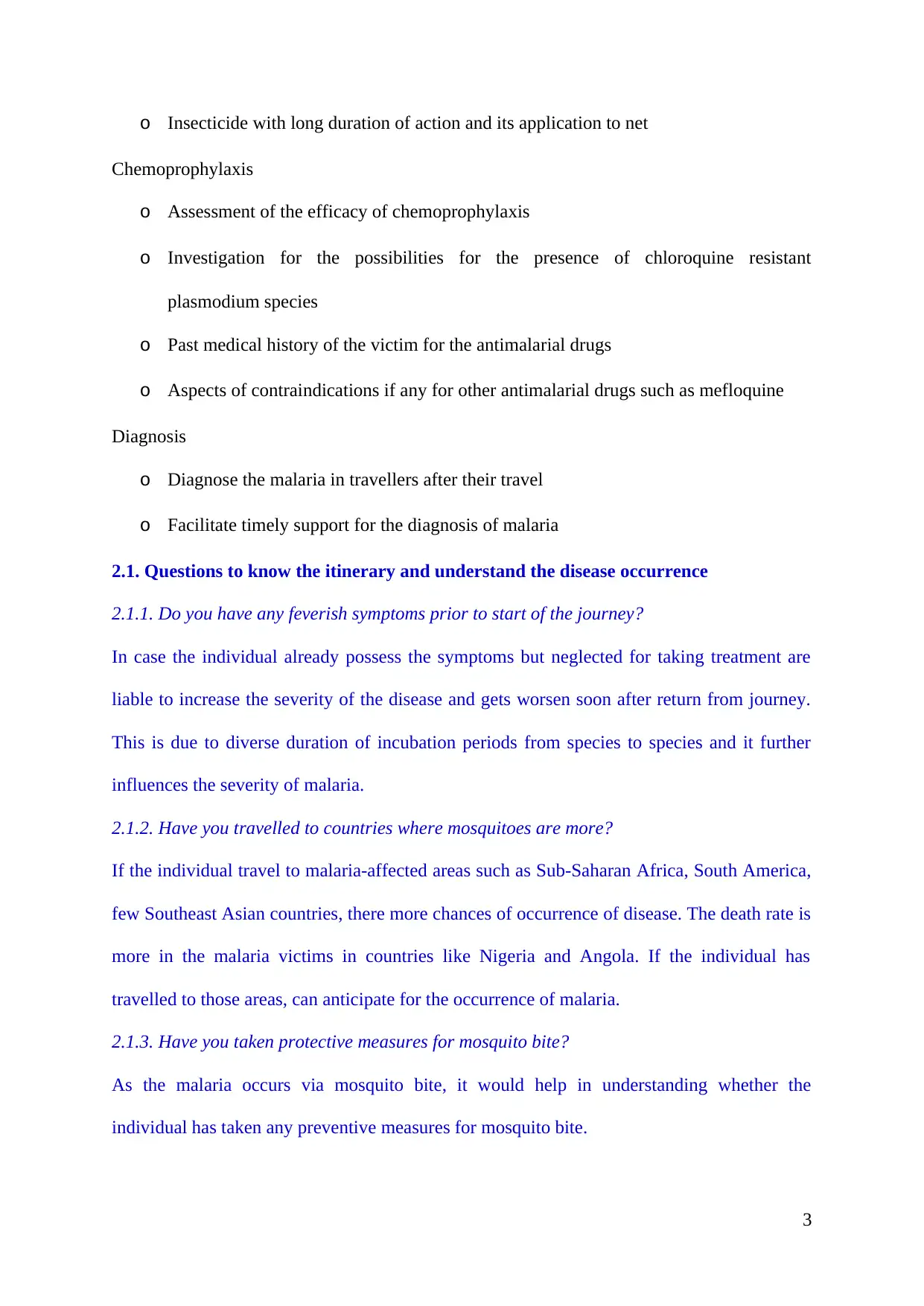
o Insecticide with long duration of action and its application to net
Chemoprophylaxis
o Assessment of the efficacy of chemoprophylaxis
o Investigation for the possibilities for the presence of chloroquine resistant
plasmodium species
o Past medical history of the victim for the antimalarial drugs
o Aspects of contraindications if any for other antimalarial drugs such as mefloquine
Diagnosis
o Diagnose the malaria in travellers after their travel
o Facilitate timely support for the diagnosis of malaria
2.1. Questions to know the itinerary and understand the disease occurrence
2.1.1. Do you have any feverish symptoms prior to start of the journey?
In case the individual already possess the symptoms but neglected for taking treatment are
liable to increase the severity of the disease and gets worsen soon after return from journey.
This is due to diverse duration of incubation periods from species to species and it further
influences the severity of malaria.
2.1.2. Have you travelled to countries where mosquitoes are more?
If the individual travel to malaria-affected areas such as Sub-Saharan Africa, South America,
few Southeast Asian countries, there more chances of occurrence of disease. The death rate is
more in the malaria victims in countries like Nigeria and Angola. If the individual has
travelled to those areas, can anticipate for the occurrence of malaria.
2.1.3. Have you taken protective measures for mosquito bite?
As the malaria occurs via mosquito bite, it would help in understanding whether the
individual has taken any preventive measures for mosquito bite.
3
Chemoprophylaxis
o Assessment of the efficacy of chemoprophylaxis
o Investigation for the possibilities for the presence of chloroquine resistant
plasmodium species
o Past medical history of the victim for the antimalarial drugs
o Aspects of contraindications if any for other antimalarial drugs such as mefloquine
Diagnosis
o Diagnose the malaria in travellers after their travel
o Facilitate timely support for the diagnosis of malaria
2.1. Questions to know the itinerary and understand the disease occurrence
2.1.1. Do you have any feverish symptoms prior to start of the journey?
In case the individual already possess the symptoms but neglected for taking treatment are
liable to increase the severity of the disease and gets worsen soon after return from journey.
This is due to diverse duration of incubation periods from species to species and it further
influences the severity of malaria.
2.1.2. Have you travelled to countries where mosquitoes are more?
If the individual travel to malaria-affected areas such as Sub-Saharan Africa, South America,
few Southeast Asian countries, there more chances of occurrence of disease. The death rate is
more in the malaria victims in countries like Nigeria and Angola. If the individual has
travelled to those areas, can anticipate for the occurrence of malaria.
2.1.3. Have you taken protective measures for mosquito bite?
As the malaria occurs via mosquito bite, it would help in understanding whether the
individual has taken any preventive measures for mosquito bite.
3
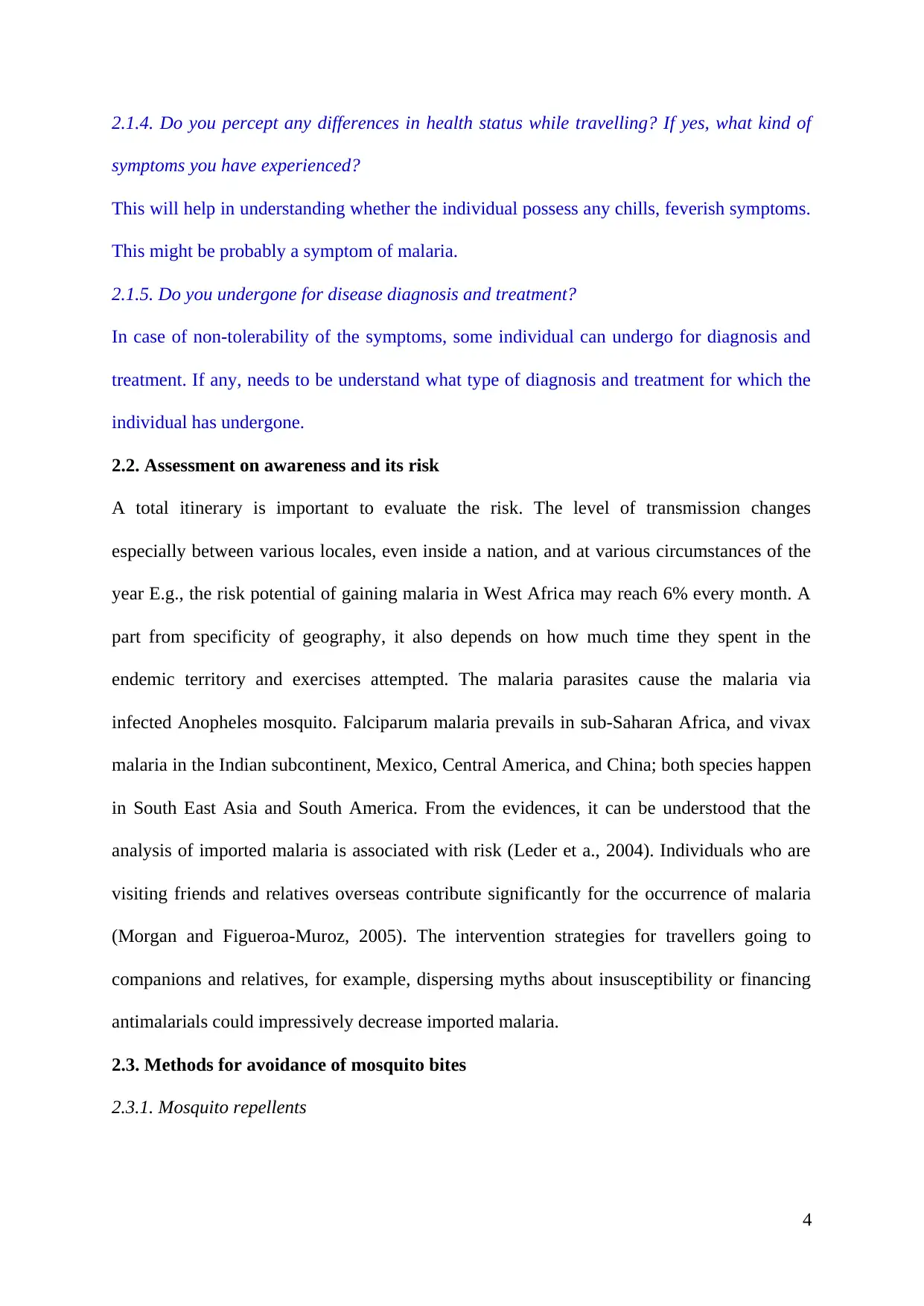
2.1.4. Do you percept any differences in health status while travelling? If yes, what kind of
symptoms you have experienced?
This will help in understanding whether the individual possess any chills, feverish symptoms.
This might be probably a symptom of malaria.
2.1.5. Do you undergone for disease diagnosis and treatment?
In case of non-tolerability of the symptoms, some individual can undergo for diagnosis and
treatment. If any, needs to be understand what type of diagnosis and treatment for which the
individual has undergone.
2.2. Assessment on awareness and its risk
A total itinerary is important to evaluate the risk. The level of transmission changes
especially between various locales, even inside a nation, and at various circumstances of the
year E.g., the risk potential of gaining malaria in West Africa may reach 6% every month. A
part from specificity of geography, it also depends on how much time they spent in the
endemic territory and exercises attempted. The malaria parasites cause the malaria via
infected Anopheles mosquito. Falciparum malaria prevails in sub-Saharan Africa, and vivax
malaria in the Indian subcontinent, Mexico, Central America, and China; both species happen
in South East Asia and South America. From the evidences, it can be understood that the
analysis of imported malaria is associated with risk (Leder et a., 2004). Individuals who are
visiting friends and relatives overseas contribute significantly for the occurrence of malaria
(Morgan and Figueroa-Muroz, 2005). The intervention strategies for travellers going to
companions and relatives, for example, dispersing myths about insusceptibility or financing
antimalarials could impressively decrease imported malaria.
2.3. Methods for avoidance of mosquito bites
2.3.1. Mosquito repellents
4
symptoms you have experienced?
This will help in understanding whether the individual possess any chills, feverish symptoms.
This might be probably a symptom of malaria.
2.1.5. Do you undergone for disease diagnosis and treatment?
In case of non-tolerability of the symptoms, some individual can undergo for diagnosis and
treatment. If any, needs to be understand what type of diagnosis and treatment for which the
individual has undergone.
2.2. Assessment on awareness and its risk
A total itinerary is important to evaluate the risk. The level of transmission changes
especially between various locales, even inside a nation, and at various circumstances of the
year E.g., the risk potential of gaining malaria in West Africa may reach 6% every month. A
part from specificity of geography, it also depends on how much time they spent in the
endemic territory and exercises attempted. The malaria parasites cause the malaria via
infected Anopheles mosquito. Falciparum malaria prevails in sub-Saharan Africa, and vivax
malaria in the Indian subcontinent, Mexico, Central America, and China; both species happen
in South East Asia and South America. From the evidences, it can be understood that the
analysis of imported malaria is associated with risk (Leder et a., 2004). Individuals who are
visiting friends and relatives overseas contribute significantly for the occurrence of malaria
(Morgan and Figueroa-Muroz, 2005). The intervention strategies for travellers going to
companions and relatives, for example, dispersing myths about insusceptibility or financing
antimalarials could impressively decrease imported malaria.
2.3. Methods for avoidance of mosquito bites
2.3.1. Mosquito repellents
4
Secure Best Marks with AI Grader
Need help grading? Try our AI Grader for instant feedback on your assignments.
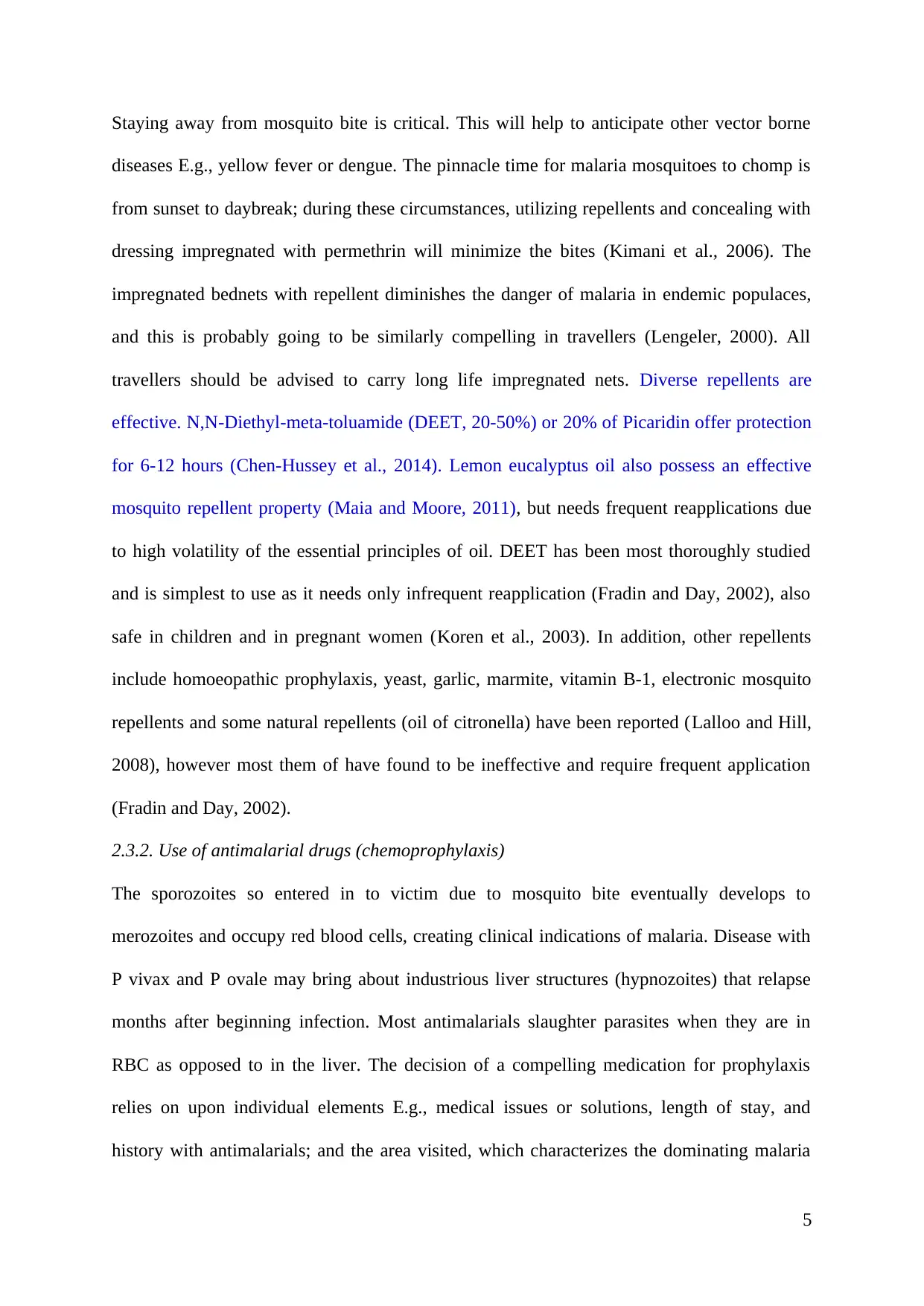
Staying away from mosquito bite is critical. This will help to anticipate other vector borne
diseases E.g., yellow fever or dengue. The pinnacle time for malaria mosquitoes to chomp is
from sunset to daybreak; during these circumstances, utilizing repellents and concealing with
dressing impregnated with permethrin will minimize the bites (Kimani et al., 2006). The
impregnated bednets with repellent diminishes the danger of malaria in endemic populaces,
and this is probably going to be similarly compelling in travellers (Lengeler, 2000). All
travellers should be advised to carry long life impregnated nets. Diverse repellents are
effective. N,N-Diethyl-meta-toluamide (DEET, 20-50%) or 20% of Picaridin offer protection
for 6-12 hours (Chen-Hussey et al., 2014). Lemon eucalyptus oil also possess an effective
mosquito repellent property (Maia and Moore, 2011), but needs frequent reapplications due
to high volatility of the essential principles of oil. DEET has been most thoroughly studied
and is simplest to use as it needs only infrequent reapplication (Fradin and Day, 2002), also
safe in children and in pregnant women (Koren et al., 2003). In addition, other repellents
include homoeopathic prophylaxis, yeast, garlic, marmite, vitamin B-1, electronic mosquito
repellents and some natural repellents (oil of citronella) have been reported (Lalloo and Hill,
2008), however most them of have found to be ineffective and require frequent application
(Fradin and Day, 2002).
2.3.2. Use of antimalarial drugs (chemoprophylaxis)
The sporozoites so entered in to victim due to mosquito bite eventually develops to
merozoites and occupy red blood cells, creating clinical indications of malaria. Disease with
P vivax and P ovale may bring about industrious liver structures (hypnozoites) that relapse
months after beginning infection. Most antimalarials slaughter parasites when they are in
RBC as opposed to in the liver. The decision of a compelling medication for prophylaxis
relies on upon individual elements E.g., medical issues or solutions, length of stay, and
history with antimalarials; and the area visited, which characterizes the dominating malaria
5
diseases E.g., yellow fever or dengue. The pinnacle time for malaria mosquitoes to chomp is
from sunset to daybreak; during these circumstances, utilizing repellents and concealing with
dressing impregnated with permethrin will minimize the bites (Kimani et al., 2006). The
impregnated bednets with repellent diminishes the danger of malaria in endemic populaces,
and this is probably going to be similarly compelling in travellers (Lengeler, 2000). All
travellers should be advised to carry long life impregnated nets. Diverse repellents are
effective. N,N-Diethyl-meta-toluamide (DEET, 20-50%) or 20% of Picaridin offer protection
for 6-12 hours (Chen-Hussey et al., 2014). Lemon eucalyptus oil also possess an effective
mosquito repellent property (Maia and Moore, 2011), but needs frequent reapplications due
to high volatility of the essential principles of oil. DEET has been most thoroughly studied
and is simplest to use as it needs only infrequent reapplication (Fradin and Day, 2002), also
safe in children and in pregnant women (Koren et al., 2003). In addition, other repellents
include homoeopathic prophylaxis, yeast, garlic, marmite, vitamin B-1, electronic mosquito
repellents and some natural repellents (oil of citronella) have been reported (Lalloo and Hill,
2008), however most them of have found to be ineffective and require frequent application
(Fradin and Day, 2002).
2.3.2. Use of antimalarial drugs (chemoprophylaxis)
The sporozoites so entered in to victim due to mosquito bite eventually develops to
merozoites and occupy red blood cells, creating clinical indications of malaria. Disease with
P vivax and P ovale may bring about industrious liver structures (hypnozoites) that relapse
months after beginning infection. Most antimalarials slaughter parasites when they are in
RBC as opposed to in the liver. The decision of a compelling medication for prophylaxis
relies on upon individual elements E.g., medical issues or solutions, length of stay, and
history with antimalarials; and the area visited, which characterizes the dominating malaria
5
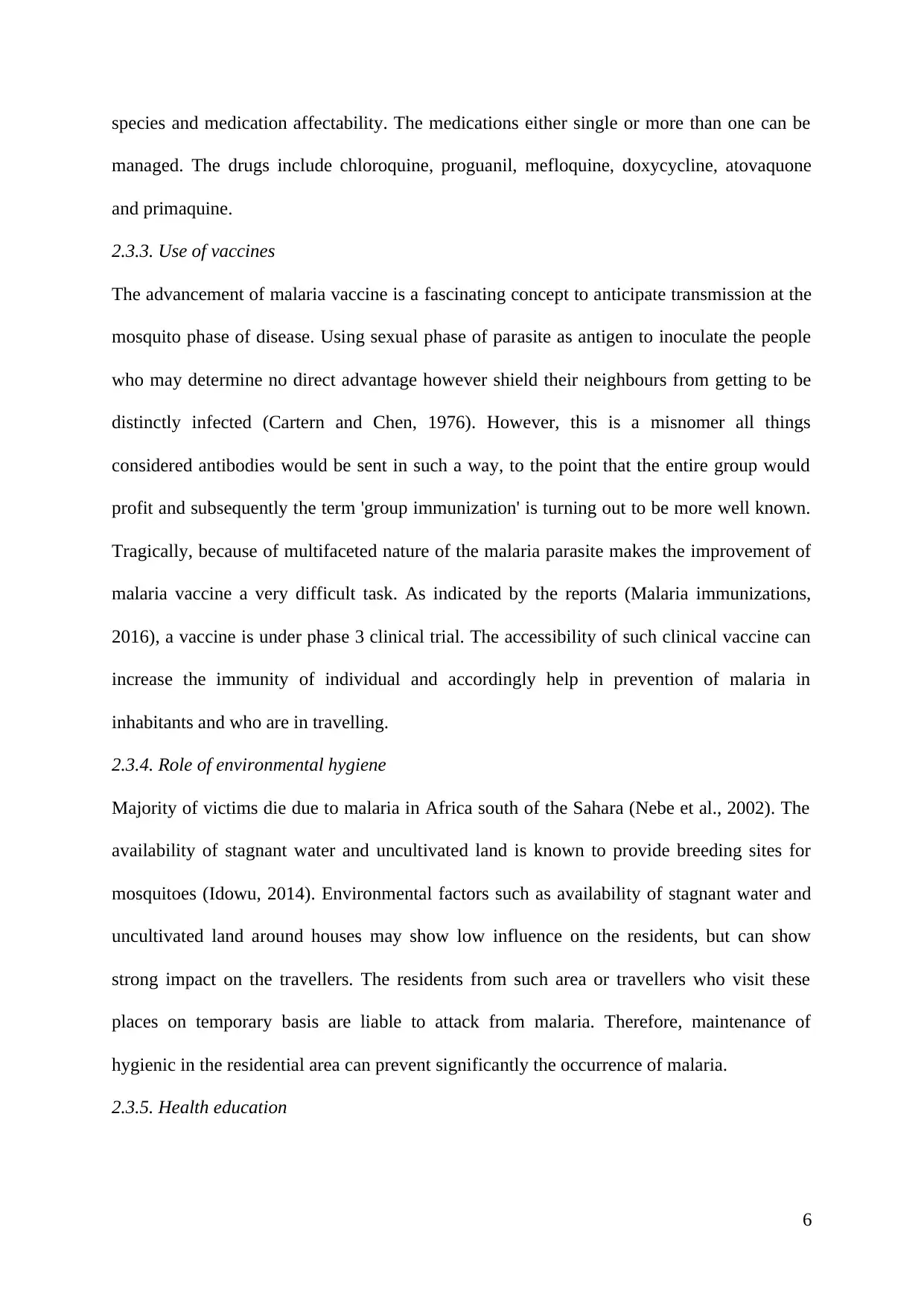
species and medication affectability. The medications either single or more than one can be
managed. The drugs include chloroquine, proguanil, mefloquine, doxycycline, atovaquone
and primaquine.
2.3.3. Use of vaccines
The advancement of malaria vaccine is a fascinating concept to anticipate transmission at the
mosquito phase of disease. Using sexual phase of parasite as antigen to inoculate the people
who may determine no direct advantage however shield their neighbours from getting to be
distinctly infected (Cartern and Chen, 1976). However, this is a misnomer all things
considered antibodies would be sent in such a way, to the point that the entire group would
profit and subsequently the term 'group immunization' is turning out to be more well known.
Tragically, because of multifaceted nature of the malaria parasite makes the improvement of
malaria vaccine a very difficult task. As indicated by the reports (Malaria immunizations,
2016), a vaccine is under phase 3 clinical trial. The accessibility of such clinical vaccine can
increase the immunity of individual and accordingly help in prevention of malaria in
inhabitants and who are in travelling.
2.3.4. Role of environmental hygiene
Majority of victims die due to malaria in Africa south of the Sahara (Nebe et al., 2002). The
availability of stagnant water and uncultivated land is known to provide breeding sites for
mosquitoes (Idowu, 2014). Environmental factors such as availability of stagnant water and
uncultivated land around houses may show low influence on the residents, but can show
strong impact on the travellers. The residents from such area or travellers who visit these
places on temporary basis are liable to attack from malaria. Therefore, maintenance of
hygienic in the residential area can prevent significantly the occurrence of malaria.
2.3.5. Health education
6
managed. The drugs include chloroquine, proguanil, mefloquine, doxycycline, atovaquone
and primaquine.
2.3.3. Use of vaccines
The advancement of malaria vaccine is a fascinating concept to anticipate transmission at the
mosquito phase of disease. Using sexual phase of parasite as antigen to inoculate the people
who may determine no direct advantage however shield their neighbours from getting to be
distinctly infected (Cartern and Chen, 1976). However, this is a misnomer all things
considered antibodies would be sent in such a way, to the point that the entire group would
profit and subsequently the term 'group immunization' is turning out to be more well known.
Tragically, because of multifaceted nature of the malaria parasite makes the improvement of
malaria vaccine a very difficult task. As indicated by the reports (Malaria immunizations,
2016), a vaccine is under phase 3 clinical trial. The accessibility of such clinical vaccine can
increase the immunity of individual and accordingly help in prevention of malaria in
inhabitants and who are in travelling.
2.3.4. Role of environmental hygiene
Majority of victims die due to malaria in Africa south of the Sahara (Nebe et al., 2002). The
availability of stagnant water and uncultivated land is known to provide breeding sites for
mosquitoes (Idowu, 2014). Environmental factors such as availability of stagnant water and
uncultivated land around houses may show low influence on the residents, but can show
strong impact on the travellers. The residents from such area or travellers who visit these
places on temporary basis are liable to attack from malaria. Therefore, maintenance of
hygienic in the residential area can prevent significantly the occurrence of malaria.
2.3.5. Health education
6
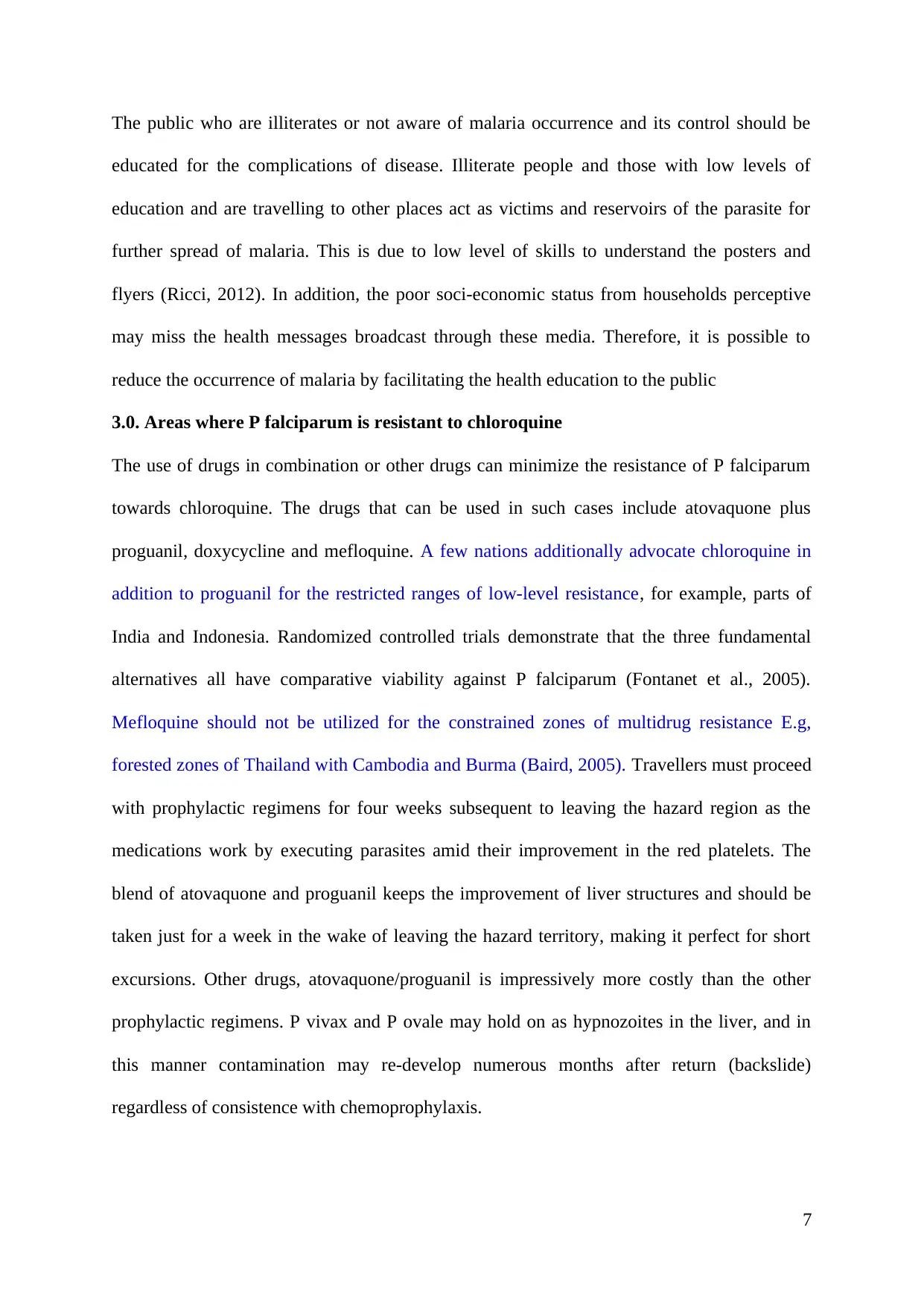
The public who are illiterates or not aware of malaria occurrence and its control should be
educated for the complications of disease. Illiterate people and those with low levels of
education and are travelling to other places act as victims and reservoirs of the parasite for
further spread of malaria. This is due to low level of skills to understand the posters and
flyers (Ricci, 2012). In addition, the poor soci-economic status from households perceptive
may miss the health messages broadcast through these media. Therefore, it is possible to
reduce the occurrence of malaria by facilitating the health education to the public
3.0. Areas where P falciparum is resistant to chloroquine
The use of drugs in combination or other drugs can minimize the resistance of P falciparum
towards chloroquine. The drugs that can be used in such cases include atovaquone plus
proguanil, doxycycline and mefloquine. A few nations additionally advocate chloroquine in
addition to proguanil for the restricted ranges of low-level resistance, for example, parts of
India and Indonesia. Randomized controlled trials demonstrate that the three fundamental
alternatives all have comparative viability against P falciparum (Fontanet et al., 2005).
Mefloquine should not be utilized for the constrained zones of multidrug resistance E.g,
forested zones of Thailand with Cambodia and Burma (Baird, 2005). Travellers must proceed
with prophylactic regimens for four weeks subsequent to leaving the hazard region as the
medications work by executing parasites amid their improvement in the red platelets. The
blend of atovaquone and proguanil keeps the improvement of liver structures and should be
taken just for a week in the wake of leaving the hazard territory, making it perfect for short
excursions. Other drugs, atovaquone/proguanil is impressively more costly than the other
prophylactic regimens. P vivax and P ovale may hold on as hypnozoites in the liver, and in
this manner contamination may re-develop numerous months after return (backslide)
regardless of consistence with chemoprophylaxis.
7
educated for the complications of disease. Illiterate people and those with low levels of
education and are travelling to other places act as victims and reservoirs of the parasite for
further spread of malaria. This is due to low level of skills to understand the posters and
flyers (Ricci, 2012). In addition, the poor soci-economic status from households perceptive
may miss the health messages broadcast through these media. Therefore, it is possible to
reduce the occurrence of malaria by facilitating the health education to the public
3.0. Areas where P falciparum is resistant to chloroquine
The use of drugs in combination or other drugs can minimize the resistance of P falciparum
towards chloroquine. The drugs that can be used in such cases include atovaquone plus
proguanil, doxycycline and mefloquine. A few nations additionally advocate chloroquine in
addition to proguanil for the restricted ranges of low-level resistance, for example, parts of
India and Indonesia. Randomized controlled trials demonstrate that the three fundamental
alternatives all have comparative viability against P falciparum (Fontanet et al., 2005).
Mefloquine should not be utilized for the constrained zones of multidrug resistance E.g,
forested zones of Thailand with Cambodia and Burma (Baird, 2005). Travellers must proceed
with prophylactic regimens for four weeks subsequent to leaving the hazard region as the
medications work by executing parasites amid their improvement in the red platelets. The
blend of atovaquone and proguanil keeps the improvement of liver structures and should be
taken just for a week in the wake of leaving the hazard territory, making it perfect for short
excursions. Other drugs, atovaquone/proguanil is impressively more costly than the other
prophylactic regimens. P vivax and P ovale may hold on as hypnozoites in the liver, and in
this manner contamination may re-develop numerous months after return (backslide)
regardless of consistence with chemoprophylaxis.
7
Paraphrase This Document
Need a fresh take? Get an instant paraphrase of this document with our AI Paraphraser
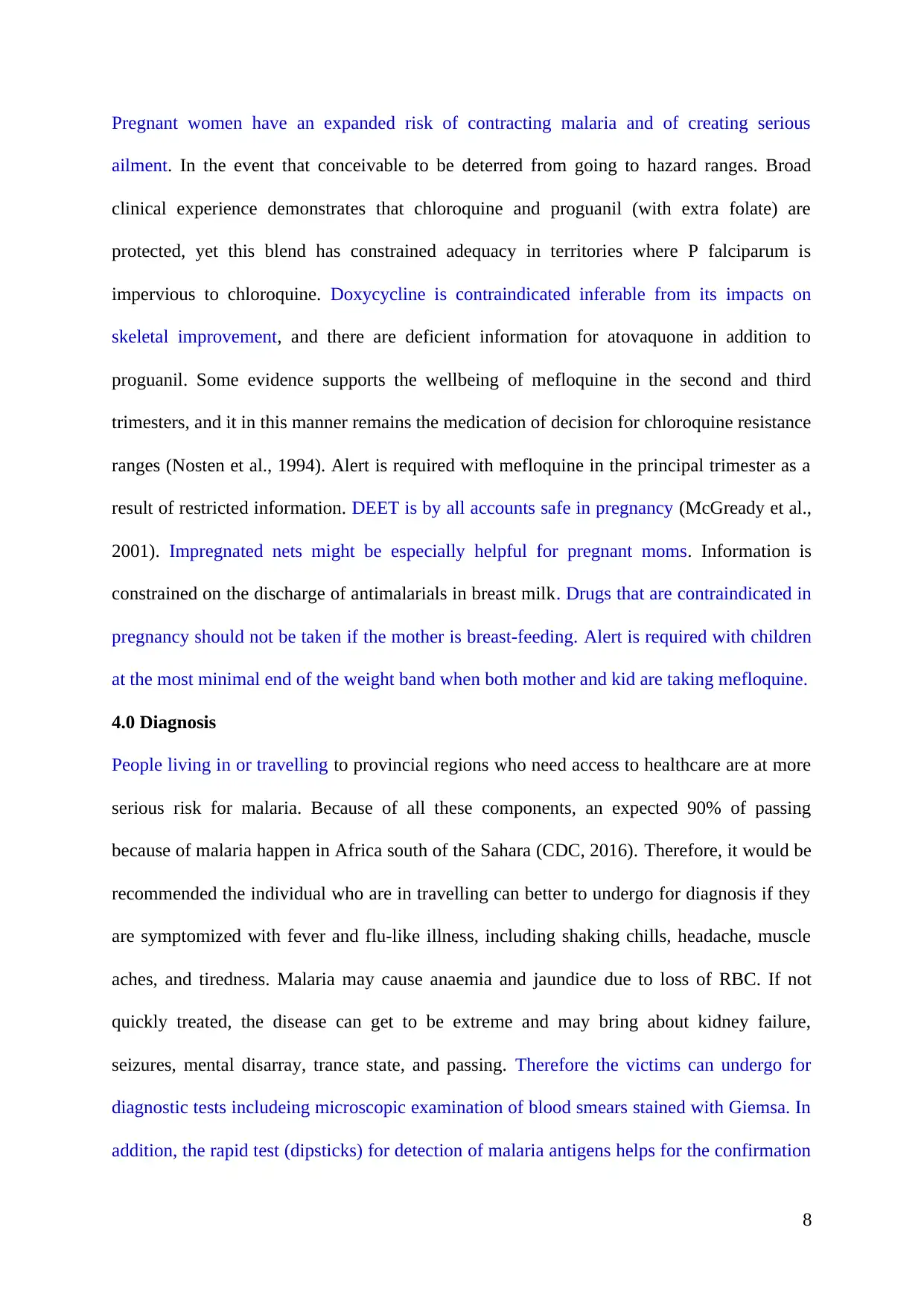
Pregnant women have an expanded risk of contracting malaria and of creating serious
ailment. In the event that conceivable to be deterred from going to hazard ranges. Broad
clinical experience demonstrates that chloroquine and proguanil (with extra folate) are
protected, yet this blend has constrained adequacy in territories where P falciparum is
impervious to chloroquine. Doxycycline is contraindicated inferable from its impacts on
skeletal improvement, and there are deficient information for atovaquone in addition to
proguanil. Some evidence supports the wellbeing of mefloquine in the second and third
trimesters, and it in this manner remains the medication of decision for chloroquine resistance
ranges (Nosten et al., 1994). Alert is required with mefloquine in the principal trimester as a
result of restricted information. DEET is by all accounts safe in pregnancy (McGready et al.,
2001). Impregnated nets might be especially helpful for pregnant moms. Information is
constrained on the discharge of antimalarials in breast milk. Drugs that are contraindicated in
pregnancy should not be taken if the mother is breast-feeding. Alert is required with children
at the most minimal end of the weight band when both mother and kid are taking mefloquine.
4.0 Diagnosis
People living in or travelling to provincial regions who need access to healthcare are at more
serious risk for malaria. Because of all these components, an expected 90% of passing
because of malaria happen in Africa south of the Sahara (CDC, 2016). Therefore, it would be
recommended the individual who are in travelling can better to undergo for diagnosis if they
are symptomized with fever and flu-like illness, including shaking chills, headache, muscle
aches, and tiredness. Malaria may cause anaemia and jaundice due to loss of RBC. If not
quickly treated, the disease can get to be extreme and may bring about kidney failure,
seizures, mental disarray, trance state, and passing. Therefore the victims can undergo for
diagnostic tests includeing microscopic examination of blood smears stained with Giemsa. In
addition, the rapid test (dipsticks) for detection of malaria antigens helps for the confirmation
8
ailment. In the event that conceivable to be deterred from going to hazard ranges. Broad
clinical experience demonstrates that chloroquine and proguanil (with extra folate) are
protected, yet this blend has constrained adequacy in territories where P falciparum is
impervious to chloroquine. Doxycycline is contraindicated inferable from its impacts on
skeletal improvement, and there are deficient information for atovaquone in addition to
proguanil. Some evidence supports the wellbeing of mefloquine in the second and third
trimesters, and it in this manner remains the medication of decision for chloroquine resistance
ranges (Nosten et al., 1994). Alert is required with mefloquine in the principal trimester as a
result of restricted information. DEET is by all accounts safe in pregnancy (McGready et al.,
2001). Impregnated nets might be especially helpful for pregnant moms. Information is
constrained on the discharge of antimalarials in breast milk. Drugs that are contraindicated in
pregnancy should not be taken if the mother is breast-feeding. Alert is required with children
at the most minimal end of the weight band when both mother and kid are taking mefloquine.
4.0 Diagnosis
People living in or travelling to provincial regions who need access to healthcare are at more
serious risk for malaria. Because of all these components, an expected 90% of passing
because of malaria happen in Africa south of the Sahara (CDC, 2016). Therefore, it would be
recommended the individual who are in travelling can better to undergo for diagnosis if they
are symptomized with fever and flu-like illness, including shaking chills, headache, muscle
aches, and tiredness. Malaria may cause anaemia and jaundice due to loss of RBC. If not
quickly treated, the disease can get to be extreme and may bring about kidney failure,
seizures, mental disarray, trance state, and passing. Therefore the victims can undergo for
diagnostic tests includeing microscopic examination of blood smears stained with Giemsa. In
addition, the rapid test (dipsticks) for detection of malaria antigens helps for the confirmation
8
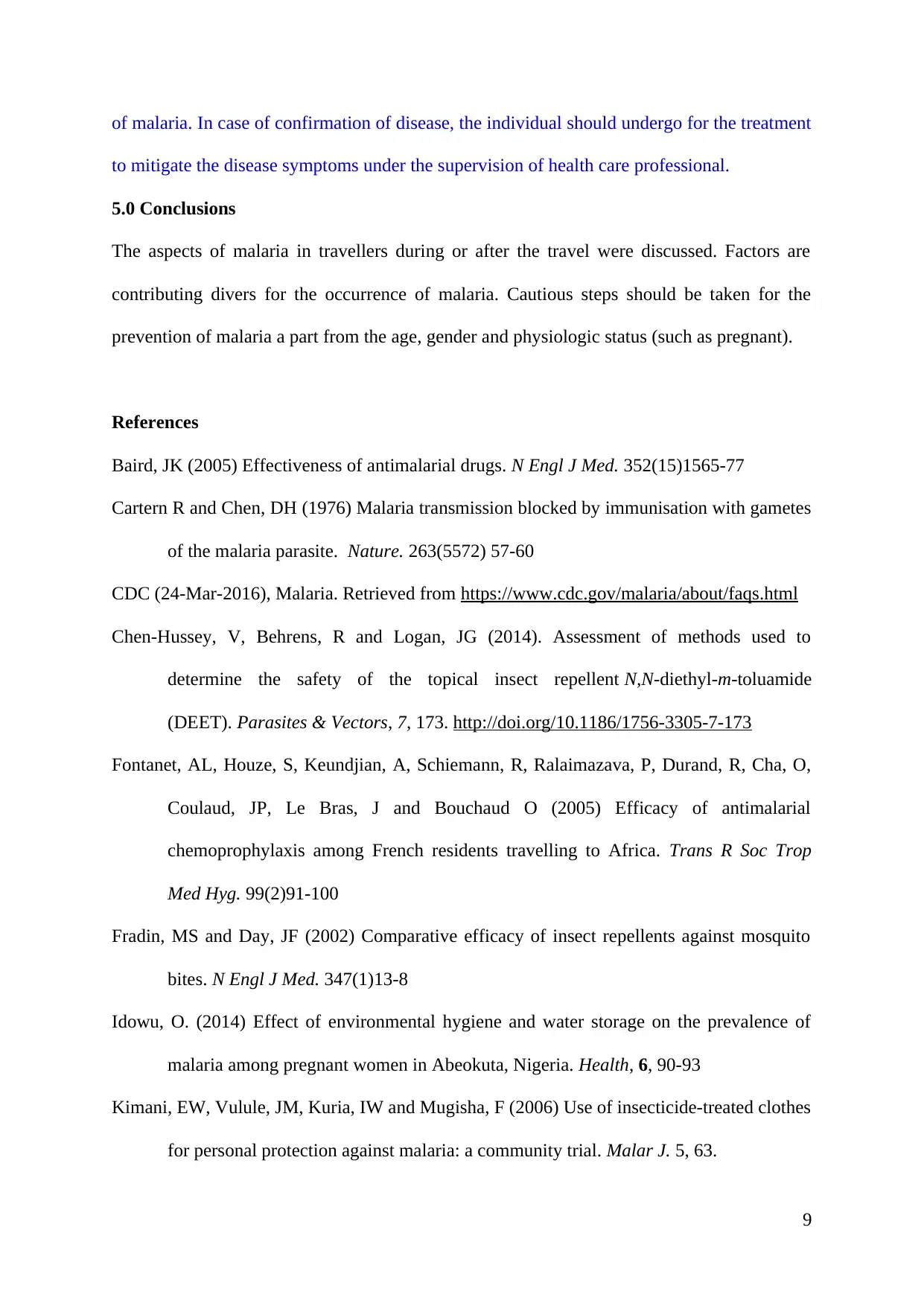
of malaria. In case of confirmation of disease, the individual should undergo for the treatment
to mitigate the disease symptoms under the supervision of health care professional.
5.0 Conclusions
The aspects of malaria in travellers during or after the travel were discussed. Factors are
contributing divers for the occurrence of malaria. Cautious steps should be taken for the
prevention of malaria a part from the age, gender and physiologic status (such as pregnant).
References
Baird, JK (2005) Effectiveness of antimalarial drugs. N Engl J Med. 352(15)1565-77
Cartern R and Chen, DH (1976) Malaria transmission blocked by immunisation with gametes
of the malaria parasite. Nature. 263(5572) 57-60
CDC (24-Mar-2016), Malaria. Retrieved from https://www.cdc.gov/malaria/about/faqs.html
Chen-Hussey, V, Behrens, R and Logan, JG (2014). Assessment of methods used to
determine the safety of the topical insect repellent N,N-diethyl-m-toluamide
(DEET). Parasites & Vectors, 7, 173. http://doi.org/10.1186/1756-3305-7-173
Fontanet, AL, Houze, S, Keundjian, A, Schiemann, R, Ralaimazava, P, Durand, R, Cha, O,
Coulaud, JP, Le Bras, J and Bouchaud O (2005) Efficacy of antimalarial
chemoprophylaxis among French residents travelling to Africa. Trans R Soc Trop
Med Hyg. 99(2)91-100
Fradin, MS and Day, JF (2002) Comparative efficacy of insect repellents against mosquito
bites. N Engl J Med. 347(1)13-8
Idowu, O. (2014) Effect of environmental hygiene and water storage on the prevalence of
malaria among pregnant women in Abeokuta, Nigeria. Health, 6, 90-93
Kimani, EW, Vulule, JM, Kuria, IW and Mugisha, F (2006) Use of insecticide-treated clothes
for personal protection against malaria: a community trial. Malar J. 5, 63.
9
to mitigate the disease symptoms under the supervision of health care professional.
5.0 Conclusions
The aspects of malaria in travellers during or after the travel were discussed. Factors are
contributing divers for the occurrence of malaria. Cautious steps should be taken for the
prevention of malaria a part from the age, gender and physiologic status (such as pregnant).
References
Baird, JK (2005) Effectiveness of antimalarial drugs. N Engl J Med. 352(15)1565-77
Cartern R and Chen, DH (1976) Malaria transmission blocked by immunisation with gametes
of the malaria parasite. Nature. 263(5572) 57-60
CDC (24-Mar-2016), Malaria. Retrieved from https://www.cdc.gov/malaria/about/faqs.html
Chen-Hussey, V, Behrens, R and Logan, JG (2014). Assessment of methods used to
determine the safety of the topical insect repellent N,N-diethyl-m-toluamide
(DEET). Parasites & Vectors, 7, 173. http://doi.org/10.1186/1756-3305-7-173
Fontanet, AL, Houze, S, Keundjian, A, Schiemann, R, Ralaimazava, P, Durand, R, Cha, O,
Coulaud, JP, Le Bras, J and Bouchaud O (2005) Efficacy of antimalarial
chemoprophylaxis among French residents travelling to Africa. Trans R Soc Trop
Med Hyg. 99(2)91-100
Fradin, MS and Day, JF (2002) Comparative efficacy of insect repellents against mosquito
bites. N Engl J Med. 347(1)13-8
Idowu, O. (2014) Effect of environmental hygiene and water storage on the prevalence of
malaria among pregnant women in Abeokuta, Nigeria. Health, 6, 90-93
Kimani, EW, Vulule, JM, Kuria, IW and Mugisha, F (2006) Use of insecticide-treated clothes
for personal protection against malaria: a community trial. Malar J. 5, 63.
9
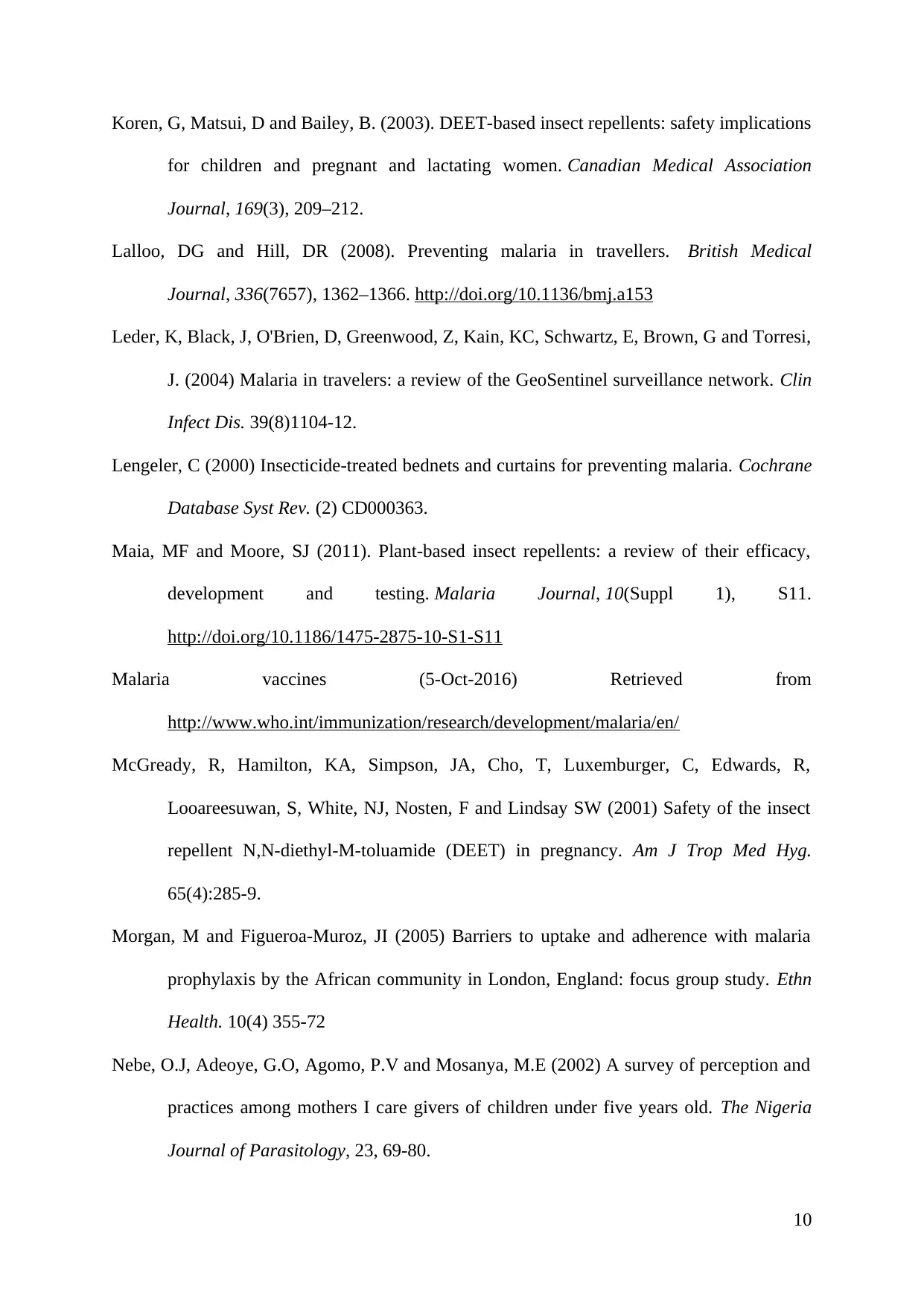
Koren, G, Matsui, D and Bailey, B. (2003). DEET-based insect repellents: safety implications
for children and pregnant and lactating women. Canadian Medical Association
Journal, 169(3), 209–212.
Lalloo, DG and Hill, DR (2008). Preventing malaria in travellers. British Medical
Journal, 336(7657), 1362–1366. http://doi.org/10.1136/bmj.a153
Leder, K, Black, J, O'Brien, D, Greenwood, Z, Kain, KC, Schwartz, E, Brown, G and Torresi,
J. (2004) Malaria in travelers: a review of the GeoSentinel surveillance network. Clin
Infect Dis. 39(8)1104-12.
Lengeler, C (2000) Insecticide-treated bednets and curtains for preventing malaria. Cochrane
Database Syst Rev. (2) CD000363.
Maia, MF and Moore, SJ (2011). Plant-based insect repellents: a review of their efficacy,
development and testing. Malaria Journal, 10(Suppl 1), S11.
http://doi.org/10.1186/1475-2875-10-S1-S11
Malaria vaccines (5-Oct-2016) Retrieved from
http://www.who.int/immunization/research/development/malaria/en/
McGready, R, Hamilton, KA, Simpson, JA, Cho, T, Luxemburger, C, Edwards, R,
Looareesuwan, S, White, NJ, Nosten, F and Lindsay SW (2001) Safety of the insect
repellent N,N-diethyl-M-toluamide (DEET) in pregnancy. Am J Trop Med Hyg.
65(4):285-9.
Morgan, M and Figueroa-Muroz, JI (2005) Barriers to uptake and adherence with malaria
prophylaxis by the African community in London, England: focus group study. Ethn
Health. 10(4) 355-72
Nebe, O.J, Adeoye, G.O, Agomo, P.V and Mosanya, M.E (2002) A survey of perception and
practices among mothers I care givers of children under five years old. The Nigeria
Journal of Parasitology, 23, 69-80.
10
for children and pregnant and lactating women. Canadian Medical Association
Journal, 169(3), 209–212.
Lalloo, DG and Hill, DR (2008). Preventing malaria in travellers. British Medical
Journal, 336(7657), 1362–1366. http://doi.org/10.1136/bmj.a153
Leder, K, Black, J, O'Brien, D, Greenwood, Z, Kain, KC, Schwartz, E, Brown, G and Torresi,
J. (2004) Malaria in travelers: a review of the GeoSentinel surveillance network. Clin
Infect Dis. 39(8)1104-12.
Lengeler, C (2000) Insecticide-treated bednets and curtains for preventing malaria. Cochrane
Database Syst Rev. (2) CD000363.
Maia, MF and Moore, SJ (2011). Plant-based insect repellents: a review of their efficacy,
development and testing. Malaria Journal, 10(Suppl 1), S11.
http://doi.org/10.1186/1475-2875-10-S1-S11
Malaria vaccines (5-Oct-2016) Retrieved from
http://www.who.int/immunization/research/development/malaria/en/
McGready, R, Hamilton, KA, Simpson, JA, Cho, T, Luxemburger, C, Edwards, R,
Looareesuwan, S, White, NJ, Nosten, F and Lindsay SW (2001) Safety of the insect
repellent N,N-diethyl-M-toluamide (DEET) in pregnancy. Am J Trop Med Hyg.
65(4):285-9.
Morgan, M and Figueroa-Muroz, JI (2005) Barriers to uptake and adherence with malaria
prophylaxis by the African community in London, England: focus group study. Ethn
Health. 10(4) 355-72
Nebe, O.J, Adeoye, G.O, Agomo, P.V and Mosanya, M.E (2002) A survey of perception and
practices among mothers I care givers of children under five years old. The Nigeria
Journal of Parasitology, 23, 69-80.
10
Secure Best Marks with AI Grader
Need help grading? Try our AI Grader for instant feedback on your assignments.
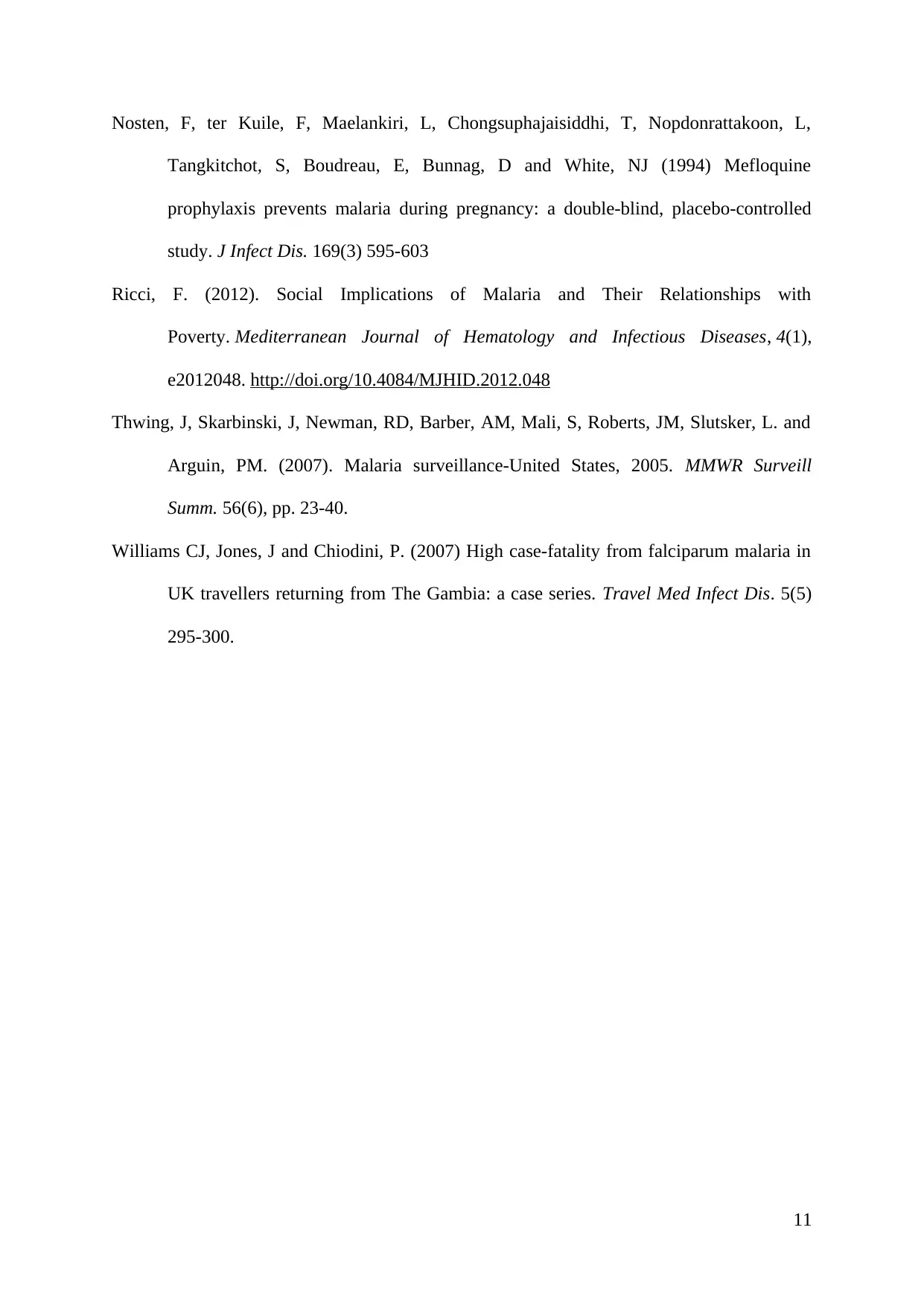
Nosten, F, ter Kuile, F, Maelankiri, L, Chongsuphajaisiddhi, T, Nopdonrattakoon, L,
Tangkitchot, S, Boudreau, E, Bunnag, D and White, NJ (1994) Mefloquine
prophylaxis prevents malaria during pregnancy: a double-blind, placebo-controlled
study. J Infect Dis. 169(3) 595-603
Ricci, F. (2012). Social Implications of Malaria and Their Relationships with
Poverty. Mediterranean Journal of Hematology and Infectious Diseases, 4(1),
e2012048. http://doi.org/10.4084/MJHID.2012.048
Thwing, J, Skarbinski, J, Newman, RD, Barber, AM, Mali, S, Roberts, JM, Slutsker, L. and
Arguin, PM. (2007). Malaria surveillance-United States, 2005. MMWR Surveill
Summ. 56(6), pp. 23-40.
Williams CJ, Jones, J and Chiodini, P. (2007) High case-fatality from falciparum malaria in
UK travellers returning from The Gambia: a case series. Travel Med Infect Dis. 5(5)
295-300.
11
Tangkitchot, S, Boudreau, E, Bunnag, D and White, NJ (1994) Mefloquine
prophylaxis prevents malaria during pregnancy: a double-blind, placebo-controlled
study. J Infect Dis. 169(3) 595-603
Ricci, F. (2012). Social Implications of Malaria and Their Relationships with
Poverty. Mediterranean Journal of Hematology and Infectious Diseases, 4(1),
e2012048. http://doi.org/10.4084/MJHID.2012.048
Thwing, J, Skarbinski, J, Newman, RD, Barber, AM, Mali, S, Roberts, JM, Slutsker, L. and
Arguin, PM. (2007). Malaria surveillance-United States, 2005. MMWR Surveill
Summ. 56(6), pp. 23-40.
Williams CJ, Jones, J and Chiodini, P. (2007) High case-fatality from falciparum malaria in
UK travellers returning from The Gambia: a case series. Travel Med Infect Dis. 5(5)
295-300.
11
1 out of 11
Your All-in-One AI-Powered Toolkit for Academic Success.
+13062052269
info@desklib.com
Available 24*7 on WhatsApp / Email
![[object Object]](/_next/static/media/star-bottom.7253800d.svg)
Unlock your academic potential
© 2024 | Zucol Services PVT LTD | All rights reserved.

